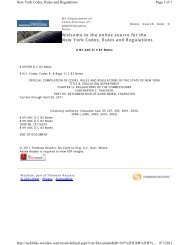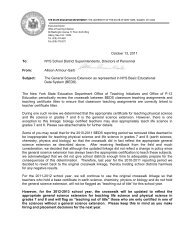ESL Learning Standards - Higher Ed - New York State Education ...
ESL Learning Standards - Higher Ed - New York State Education ...
ESL Learning Standards - Higher Ed - New York State Education ...
Create successful ePaper yourself
Turn your PDF publications into a flip-book with our unique Google optimized e-Paper software.
Advanced<br />
Teacher shows students four or five objects that are important<br />
in her life. Students speculate on the identity and purpose<br />
of each object and its meaning to the teacher. They<br />
write a short story about the teacher, using objects as clues.<br />
Teacher writes and reads his/her own story to class.<br />
Students discuss and reflect on differences between perception<br />
and reality.<br />
Performance indicators: 1, 2, 3, 7, 9<br />
English Proficiency Level<br />
Transitional<br />
Each student secretly puts four or five personal objects in a<br />
bag. Students randomly choose a bag and study the<br />
objects. They predict the owner and the significance of the<br />
objects and write a story about the owner based on the<br />
objects. True identity is revealed only after all have<br />
guessed. Owners comment in writing on validity of stories.<br />
Performance indicators: 1, 2, 3, 7, 9<br />
Students complete Intermediate task. They discuss the pros<br />
and cons of wearing hats in school, using a T-chart to track<br />
the discussion. They invite school administrator(s) to their<br />
class to comment on T-chart and answer questions.<br />
Students write a summary of the administrator’s position<br />
and compare it to their own. As a class, students write a<br />
thank-you letter to administrator, including their personal<br />
position on students’ wearing hats in school.<br />
Performance indicators: 1, 3, 6, 7, 8<br />
Students complete Advanced task through discussion with<br />
school administrator. Using T-chart, they design a schoolwide<br />
survey. They tally the results and graph the findings.<br />
Then they reassess their personal positions and write a<br />
position paper, using the writing process. The class votes<br />
on the two papers that best represent each point of view.<br />
Winning papers are submitted to school newspaper.<br />
Performance indicators: 1, 2, 3, 4, 6, 7<br />
Teacher presents background information on the death<br />
penalty (i.e., timeline, legalization, U.S./international status,<br />
criteria, methods, etc.). Questions and answers follow. In<br />
two groups (pro/con), students outline aspects of issue for<br />
research, and each member researches one aspect of issue.<br />
Teams collaborate to develop position paper, and they present<br />
positions in preparation for referendum. Then they<br />
hold a mock referendum with ballot.<br />
Performance indicators: 1, 2, 3, 4, 6, 7, 8, 9<br />
Teacher presents background information on the death<br />
penalty (i.e., timeline, legalization, U.S./international status,<br />
criteria, methods, etc.). Questions and answers follow. In<br />
two groups (pro/con), students outline aspects of issue for<br />
research, and each member researches one aspect of issue.<br />
Teams collaborate in preparation for a debate. Class agrees<br />
on debate protocol. Debate is staged and videotaped.<br />
Videotape is reviewed and scored.<br />
Performance indicators: 1, 2, 3, 4, 6, 7, 8, 9<br />
<strong>ESL</strong><br />
3<br />
Interm<br />
CLASSROOM<br />
TASKS<br />
Sample Classroom Tasks 79
















